

Jargon is a useful area of language, used to facilitate interpersonal communication in a technical activity by reducing the number of syllables necessary to refer to something. The incomplete list below is largely related to radio; of course tape has been replaced by digital systems so some of these terms are no longer in common use.
actuality: documentary material used in a news or feature programme, often political statements or location recordings of happenings such as riots.
back-announce: to make an announcement following a programme or insert, often to read the credits. back-announcement: such an announcement; often referred to as an 'outro' (facetious, from 'intro' (q.v.), and with fewer syllables).
 cans:
headphones (dating from the days when they were metal, heavy,
uncomfortable and the headband could catch your hair).
cans:
headphones (dating from the days when they were metal, heavy,
uncomfortable and the headband could catch your hair).
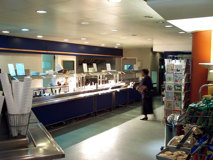 canteen:
(officially the 'Staff Restaurant') - an area providing inexpensive,
nutritious and tasty meals, often the subject of heavy irony (as here).
Now obsolete in many studio centres, replaced by tea-bar, vending-machine, or
the local pub.
canteen:
(officially the 'Staff Restaurant') - an area providing inexpensive,
nutritious and tasty meals, often the subject of heavy irony (as here).
Now obsolete in many studio centres, replaced by tea-bar, vending-machine, or
the local pub.clean feed: (known as 'mix minus' in the USA) - the output of the studio sent to a distant contributor, but not including his own contributions to avoid howl-rounds. Essential when the other end is also recording or broadcasting, on long lines (because of the delay) or telephone lines (which mix the sound in both directions).
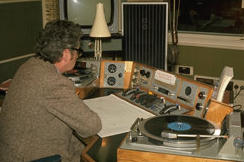 continuity:
a studio with announcer through which programmes are routed to a
network: the announcer has control of the programmes and provides the
links between them (and covers if there is a failure). The method was
introduced only in 1939, with the expected unreliability of landlines
from remote studios: up to then the announcers had been in the studios
for each programme.
continuity:
a studio with announcer through which programmes are routed to a
network: the announcer has control of the programmes and provides the
links between them (and covers if there is a failure). The method was
introduced only in 1939, with the expected unreliability of landlines
from remote studios: up to then the announcers had been in the studios
for each programme. 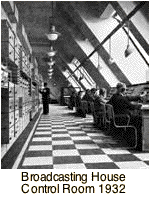 control
room:
the technical area in a studio centre reponsible for routing studios to
networks, networks to transmitters, and incoming contributions to
studios or other technical areas.
control
room:
the technical area in a studio centre reponsible for routing studios to
networks, networks to transmitters, and incoming contributions to
studios or other technical areas.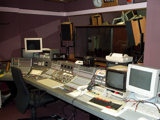 cubicle:
the
room in a studio area containing the mixing desk and technical
equipments (originally control
cubicle, and before that control
room
- this designation was dropped to avoid confusion with the main
technical and routing area). In television the equivalent function is
carried out in the 'gallery'.
cubicle:
the
room in a studio area containing the mixing desk and technical
equipments (originally control
cubicle, and before that control
room
- this designation was dropped to avoid confusion with the main
technical and routing area). In television the equivalent function is
carried out in the 'gallery'.cue: as in stage drama, the line leading to another contributor's line or a tape item; also the paragraph read before a tape item to introduce it (also known as intro).
cue-light: a green light operated from the cubicle (q.v.) to indicate to a contributor that they should go ahead; generally referred to as a green.
cue programme: a feed of the studio output sent to a distant contributor for cueing purposes (including his own contribution), which also includes the transmission talkback (q.v.) and so is not intended for broadcasting.
 desk:
the assembly of
level controls
(faders,
q.v.) and other controls used to mix the various sound sources.
Originally called the mixing panel
(q.v.).
desk:
the assembly of
level controls
(faders,
q.v.) and other controls used to mix the various sound sources.
Originally called the mixing panel
(q.v.).D.J.: Disk-Jockey - a presenter who introduces records, usually playing them himself rather than having a Studio Manager to do it. Standard method of operation in local radio, particularly in America.
dub (v): several meanings in different situations. Common usage: to confer a knighthood, rank, title or nickname upon (archaic). Radio: to make a copy. Television: to make the final mix of audio tracks into the soundtrack for a film or assembled video (in cinema, 're-record'). Cinema: to replace a voice on a soundtrack by another, either by pre-recording singing which another performer can mime to, or re-recording the speech to replace by another voice or language. (However when the same actor re-records dialogue - for example to get better quality than the original performance recording - this is known as 'post-synchronization', 'looping' or, more recently 'ADR' - Automatic Dialogue Replacement.) (Also dubbing (adj) as in 'Film dubbing mixer' (television); and dubbing (n), a copy: in gramophone records a 78rpm record copied from another rather than made from the original matrix.)
echo: strictly, reverberation (continuous and decaying rather than a single or multiple individual repeats), usually when added artificially from a special room, plate, spring or digital device. Used for dramatic effect or to appear to increase the size of the room or hall in use.

 fader:
the
level control on each channel of a mixing desk
(q.v.).
Originally rotary, later linear as the number of channels increased
from around 5-8 to 30 or more. Rotary types had a succession of studs
with a wiper passing over them, to provide increased attenuation from
stud to stud by an inaudible amount each time, though the studs could
get noisy: linear faders have a carbon track (as on ordinary volume
controls but higher quality) providing continuously variable
attenuation.
fader:
the
level control on each channel of a mixing desk
(q.v.).
Originally rotary, later linear as the number of channels increased
from around 5-8 to 30 or more. Rotary types had a succession of studs
with a wiper passing over them, to provide increased attenuation from
stud to stud by an inaudible amount each time, though the studs could
get noisy: linear faders have a carbon track (as on ordinary volume
controls but higher quality) providing continuously variable
attenuation.feedback: as with cue programme, a feed of the studio or network output sent to a distant contributor, but not including any talkback.
insert: an item forming part of a programme, usually a tape or other pre-recorded (q.v.) item, though not usually applied to records or other music.
intro: short for 'introduction' - the paragraph read before an insert (q.v.), also the cue.
 leader:
length of white or yellow (for mono) or blue (for stereo) tape (without
oxide)
cut into a sound recording tape to indicate the beginning of the
programme (and thus after the line-up tone, if any) - mostly abandoned
by the end of the tape recording era. The BBC used to have white
printed leaders you wrote the programme title on and cut onto the
beginning of the tape, before the tone, but this was abandoned many
years back (fortunately, as they were a pain to write out).
leader:
length of white or yellow (for mono) or blue (for stereo) tape (without
oxide)
cut into a sound recording tape to indicate the beginning of the
programme (and thus after the line-up tone, if any) - mostly abandoned
by the end of the tape recording era. The BBC used to have white
printed leaders you wrote the programme title on and cut onto the
beginning of the tape, before the tone, but this was abandoned many
years back (fortunately, as they were a pain to write out).listening copy: sounds like a tautology as all recordings are made to be listened to, but used for a reference copy for the producer to take away and listen to (more common in the days when they were not allowed to handle tapes), and where technical quality is not a primary concern. Originally on tapes, later more usually on cassettes for ease of use. (Not usually needed in digital systems where authorised persons can have immediate access from any workstation.)
 line:
short for landline; wired connection between one geographical location
or another, or between technical areas in one building. (Now often
replaced by a satellite connection for non-permanent usages). A music line is of
high quality, suitable for music or any broadcast material; a control line
is a telephone-quality line associated with it and used for technical
communication. Most long-distance connections are now digital.
line:
short for landline; wired connection between one geographical location
or another, or between technical areas in one building. (Now often
replaced by a satellite connection for non-permanent usages). A music line is of
high quality, suitable for music or any broadcast material; a control line
is a telephone-quality line associated with it and used for technical
communication. Most long-distance connections are now digital.log: a written explanation of something which went wrong, ideally explaining (1) when it happened, (2) what happened, and (3) why it was the fault of another Department.
monitor (n): a high quality loudspeaker (radio) or television screen (tv) used to assess the quality of a programme. (v): to listen to or view a programme as recorded or transmitted, usually to assess technical quality rather than content.
network: a continuous broadcast stream containing successive different programmes, e.g. Radio 2, BBC1.
O.B.: Outside Broadcast: a complete programme originating at a distant location.
outro: (facetious, from 'intro') closing announcement to an insert (q.v.) - see back-announce.
 panel:
obsolete term for desk
(q.v.); survives in the term 'panel
SM'
- the Studio Manager who operates the mixing desk as opposed to the
assistant SM who plays tapes and disks (or used to); also (v) 'to panel', to operate
the desk.
panel:
obsolete term for desk
(q.v.); survives in the term 'panel
SM'
- the Studio Manager who operates the mixing desk as opposed to the
assistant SM who plays tapes and disks (or used to); also (v) 'to panel', to operate
the desk.PasB: Programme as Broadcast; a detailed list of all items in a transmission, kept permanently for copyright and legal reasons.
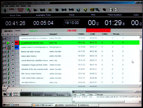 playlist:
originally a
selection of
records (usually the top 30) from which a disk-jockey
(D.J., q.v.)
could make his selection: now the list of items in a computer-based
playout system - the playlist does not contain the inserts
themselves,
just points to them, so that deleting an item from the playlist does
not delete the original.
playlist:
originally a
selection of
records (usually the top 30) from which a disk-jockey
(D.J., q.v.)
could make his selection: now the list of items in a computer-based
playout system - the playlist does not contain the inserts
themselves,
just points to them, so that deleting an item from the playlist does
not delete the original.pot: short for 'potentiometer', old-fashioned term for fader (q.v.) - survives in the term pot-cut, to close the fader rapidly on an insert to bring it to an early end (hopefully at the end of a sentence).
prefade: (from pre-fader) (1) a closing piece of music started silently and timed to finish at the scheduled closing time of the programme, faded up at the end of speech as a method of keeping a programme to the required length. (2) to listen to a recording, microphone or incoming line which has not been faded up, without the audio becoming part of the programme.
pre-recorded: sounds like a tautology, since any recording must be recorded before it can be played back, but specifically means a section of a programme recorded in advance and played into the recording or transmission, e.g. to include a complex sequence which may require editing.
producer: in radio, the person in charge of the programme - the 'director' in films and television, where the producer is in overall charge, a function carried out in radio by the Department Head or Programme Organizer.
P.T.T. : Pre-transmission-test: a check prior to transmission between the network and the studio that the audio line and red light work, that the clocks match, and everything is ready to go ahead. (Subsequently in the World Service, when networks are unmanned, replaced by a single button pressed by the Studio Manager to indicate his or her presence).
 red
light:
(or just red)
- remotely or locally controlled red light inside and outside studios
to indicate that recording or transmission is taking place. During
transmissions this is controlled by the network to which the studio is
contributing.
red
light:
(or just red)
- remotely or locally controlled red light inside and outside studios
to indicate that recording or transmission is taking place. During
transmissions this is controlled by the network to which the studio is
contributing.spacer: length of yellow tape (without oxide) cut into a sound recording tape between two separate items to allow easy setting up. More usually referred to as a yellow.
S.B.: simultaneous broadcast: a programme going to more than one network; also the routing of a network to several transmitters.
S.M.: Studio Manager. In the 1930s the Studio Manager was in effect a Floor Manager, overseeing the studio area and artists while the mixing was done by engineers or the producer; later responsible for mixing and playing in recorded material in the cubicle - originally seen as a mainly artistic and non-technical job, though this changed with the increasing complexity of equipment.
signature tune: (short, sig. tune), a short piece of music associated with a particular programme and played at the beginning and often the end to identify it. The invention of the concept is credited to music-hall artist Albert Whelan, who whistled 'The Jolly Brothers' at the beginning of his act.
simulrec: a programme involving local and distant contributors which is recorded at both ends so that the further end can be cut into the recording, providing higher quality than the line connecting them. With present-day higher quality connections this is rarely necessary.
spot effects: sound effects which are created in the studio (such as footsteps, doors, clinking teacups) rather than being pre-recorded (thunder, trains) either specially or from a library: may be performed at the time of initial recording or added afterwards. In American cinema these latter are known as 'Foley' effects.
sting: a short, usually punchy, musical phrase, used to punctuate a programme: frequently over-used (e.g. between headlines or news items).
 studio:
1. A technical area consisting of a room for the performance of speech,
music or effects, usually together with a control area containing a
mixing desk and other equipment. 2. The performance area itself within
an overall studio. See also cubicle.
studio:
1. A technical area consisting of a room for the performance of speech,
music or effects, usually together with a control area containing a
mixing desk and other equipment. 2. The performance area itself within
an overall studio. See also cubicle.talkback: speech from the control cubicle fed (using a key) to the studio to instruct contributors, or down a line to instruct distant contributors. rehearsal talkback goes onto the studio output, used for example during recordings to identify sections or instruct a remote recording channel to start. transmission talkback goes only to the studio, and only when the microphones are not active, and into cue programme (q.v.), but for obvious reasons not onto the output. Rehearsal talkback is disabled when a red light is received from a network: older desks did not do this automatically, with sometimes embarassing results.
tone: ('line-up tone') continuous sinewave (pure without harmonics) sound, usually at 1kHz and at 'zero level' - 8dB below maximum permitted level; used to align the sound level of lines or recordings. In pre-digital 'Post Office' type lines 'zero level' tone is defined as 1 milliwatt into 600Ω (o.775 volts). Not necessary with modern digital recordings.
trail: (n) an announcement or short recording designed to publicize a forthcoming programme (from cinema usage, 'trailer', so-called because these were normally glued onto the end of a feature reel). (v) to make such an announcement or play such a recording. cross-trail: announce a forthcoming programme on a different network.
trailer: length of red tape (without oxide) cut into a sound recording tape at the end of the programme to indicate where it is. More usually referred to as a red. Sometimes with red-and-white alternating sections (much easier to see).
voiceover: in radio, a section of speech performed over music or effects which are (hopefully) reduced in level to accomodate it: often spoken over the introductory music of a song, before the vocal. In films and television, the narration or commentary spoken by an unseen performer.
